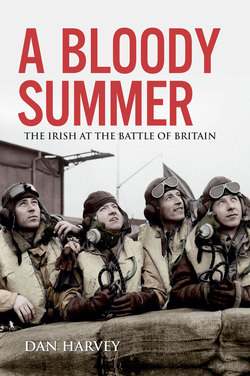Читать книгу A Bloody Summer - Dan Harvey - Страница 11
На сайте Литреса книга снята с продажи.
Оглавление1
SCRAMBLE
The sun shone with a soft quivering light through the seemingly translucent trees. Soon the mood altered and became one of challenge; one of daring and dread. Both militarism and apprehension hung in the air. Moral strength, fortitude and determination were required in responding to the threat of German bombing raids. Such character was evident throughout No. 65 Squadron at RAF Hornchurch in Essex, in late July 1940, not long after the Battle of Britain began.
One among them was Dubliner ‘Paddy’ Finucane. Brendan Eamonn Fergus Finucane was born in Dublin on 16 October 1920. In 1936, at the age of 16, he moved with his family from Dublin to Richmond in England. He joined the RAF as a trainee pilot in April 1938 and qualified as a fighter pilot flying the Supermarine Spitfire.
The pilots and crew at Hornchurch airfield held no illusions about what the day might hold and they sat poised to go skyward when called. Each coped with this oppressive weight in their own way. They had lost comrades over the preceding weeks and were all aware of the dangers, but the human impulse is to shrug off such admissions of fear. Overall the prevailing sense, while subdued, was stoical, resigned and forbearing. Calm and uncomplaining, they found comradeship sufficient insulation against fear. Their nerves were also helped by faith, both in each other and in the supports of the RAF: a warning system which employed the latest technology and was proving invaluable; the Spitfire and Hurricane aircraft, which were a match for the latest German aircraft; and RAF tactics, leadership and discipline, which were measuring up to the task facing them.
Battle-hardened veterans and fresh-faced newcomers, from England, the Commonwealth and beyond, were bound together despite differences in knowledge and skill; they were made ready to confront the German grab for air supremacy which, if successful, would act as a prelude to an invasion of the south coast of England. It was a battle for control of the skies over Britain and the RAF Fighter Command’s task was to deny it to the enemy.
To achieve this, getting fighter aircraft into the air as quickly as possible was vital. It was crucial to get off the ground and into the correct position in order to intercept and shoot down German bombers, dive bombers, fighter bombers and fighter aircraft. Only this would dissuade Hitler, Goering and the German High Command from proceeding with their invasion plans. The aerial combat exchanges had been intense and were increasingly frequent. There was a lot at stake and both sides were committed to the fight.
The rising sun on that late July morning in the long, hot summer of 1940 had just risen above the airfield’s tree line when the alarm screamed, its shrill sound splitting the air. The standard routine of the duty shift, only just begun, was already splintered, the calm transformed into clamour, with pilots and aircrew surging towards the aircraft in a flat-out sprint. There was an immediate need to get the Spitfires and Hurricanes into motion – a critical race against time. They were scrambled and the time it took to organise themselves had to be pared to an absolute minimum. Hearts pounded and pulses raced; everyone in the airfield experienced different degrees of a heady dizziness. They all tried to come to terms with what was happening in horizons beyond. Why, this time, had the alarm sounded? What was the nature of what awaited them in the sky? What was the danger and what needed to be done to prevent an unfavourable ending?
Pre-rehearsed drills were put into play and emergency positions were taken. The reactions of the pilots and crew had to be right – perfect, in fact – and there was no margin for error or second chances. British lives were at stake. Their minds were clear, however. Uppermost was only one thought: that no one ‘Hun’ was getting through today.
To achieve this, they had to get the aircraft sky-bound. The pilots had to ‘switch on’ mentally while the anxious ground crews sought to prepare the aircrafts’ engines by quickly connecting an external power supply. This was called a ‘Trolley Acc’ (Trolley Accumulator) – a two-wheeled, enclosed hand cart containing accumulators, each having a thick cable which plugged in through a flap in the engine cowling; two rechargeable six-or-twelve-volt lead acid batteries provided the power needed. Small and light enough, ground crews were able to move them with little effort. Meanwhile the pilots, having previously placed their parachutes in the cockpit, or on the wings, and who had hung their helmets on the control column or gunsight, were quickly settling into their cockpits. They hurriedly completed the pre-flight instrumentation checks before taxiing on to the airfield proper; they then pushed forward on the throttle, gained engine speed, achieved lift and accelerated off over the near horizon to face whatever was beyond.
